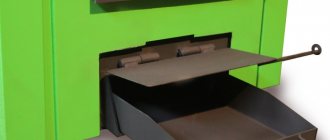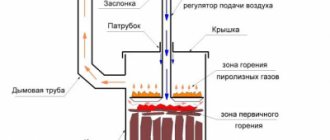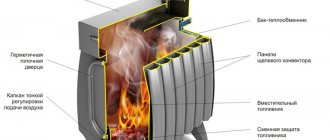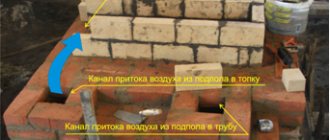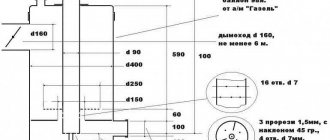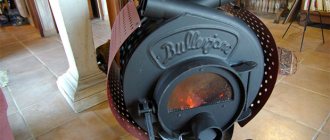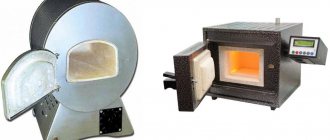Gas generators or long-burning stoves are effective heating units that can be used to heat dachas, country cottages or other private buildings. These installations are distinguished from traditional furnace designs by a special combustion mode. This method of fuel combustion contributes to the formation of an organic gaseous product with a significant specific heat capacity. The main advantages of long-burning heating units are a fairly high efficiency (approximately 80%) and the ability to heat a room with one load of firewood for about half a day.
Advantages and disadvantages
Like any device, a long-burning stove has its advantages. They are as follows:
- Long period of operation on a disposable fuel supply (burning time largely depends on the stove model: from 10 to 20 hours).
- Modern models can function autonomously (that is, constant control of the owner is not required).
- Compact and light weight.
- Variability of fuel (it can be coal fuel, wood, pellet and others).
- The presence of a foundation is not important.
- The stove does not need to be lit regularly. It can easily withstand periods of stagnation and the absence of the owner in winter (when installed in a country house).
- The fuel is burned almost completely, and there is very little ash.
- The efficiency reaches up to 90%.
- No smoke or harmful gases.
- If desired, you can install it yourself.
- Relatively low price for devices of this type.
In the assortment of some manufacturers you can find a long-burning stove with a hob. Such heating structures are perfect for a summer residence.
Stove with burner
Long-burning wood heating stoves do not have any significant disadvantages. There are only conditions in which it is not recommended to install these units:
- Lack of possibility of using liquid fuel.
- Certain requirements for chimney pipes (for example, the chimney should not be curved due to low draft).
- Relatively complex setup.
- The appearance of liquid vapor due to the entry of gases with a low temperature into the chimney pipes.
- Some models still require constant supervision by the owner.
When you purchase a long-burning wood stove for your home, you will be given instructions. However, there are nuances that she does not indicate. These should be noted:
- The chimney must be of a collapsible type (since there is a need for periodic cleaning of chimney pipes).
- It is necessary to install fire protection around the stove.
When installing a long-burning wood-burning stove in a wooden house, it is worth laying a sheet of metal or fire-resistant glass. The distance between the door and the wall should be at least 1.2 m. The distance from the stove to another wall should be 0.5 m. The heating device can be mounted closer to the wall only if there is an obstacle on the wall.

Fireproof glass oven
Necessary materials
The materials we need to make a gas generator furnace can be found in any garage. Fuel consumption will be approximately 12 kilograms per hour. So, we will need:
- Cord;
- Asbestos sheet;
- Steel sheet (1.5 by 6 meters) 6 millimeters thick;
- The same sheet 4 millimeters thick;
- Temperature control equipment;
- Steel pipe 13 meters long;
- Cast iron sheet, dimensions - 90 by 65 centimeters;
- One fan;
- Grate (its dimensions are the same as those of the cast iron sheet);
- Bricks, about 100 pieces;
- Two-meter iron rod;
- Electrodes (eight packs).
We will equip the external part of the unit with steel, and the internal part with cast iron (that is, the one into which water will be poured). We will need exclusively dry fuel.
Design and principle of operation of a long-burning wood-burning stove
An ordinary stove, which is heated with wood, burns fuel in 2-3 hours. The room temperature rises quickly, but drops just as quickly. Therefore, firewood needs to be added frequently, and this is not very convenient, especially at night. In addition, such a device takes oxygen from the room, and some heat is removed through the chimney pipes.
Long-burning wood-burning models for heating a house can be made of cast iron or steel (sheet thickness from 3 to 6 mm). Their design characteristics differ from standard stoves. Their firebox has two parts and is characterized by greater capacity. In some models you can even observe an air convection system or a water heat exchanger.
The main feature of these heating devices is the ability to operate in two modes. If you need to heat an area in a short period of time, the damper opens fully and the ash pan extends a couple of centimeters. Long burning mode is needed to maintain a stable temperature.
In a convection oven, wood burns rather slowly, with a small amount of oxygen and at an elevated temperature.
These conditions exist due to loading a large amount of firewood and cutting off the incoming air (blocked by a damper and a blower). The logs smolder, not burn. Moreover, only a small part of them. The main amount of fuel only heats up and releases flammable fuel gas, which in the future also burns and thereby provides the rooms with heat. That is why a wood-burning gas stove has a much higher efficiency.
Do-it-yourself installation according to the drawing: power calculation 2.5 MW
Considering the fact that factory-made gas generator boilers are expensive and the design is simple, owners increasingly prefer to make the unit with their own hands. This is not difficult, but the work requires the following steps:
- Creating a diagram. The device and the drawing are inseparable concepts. Calculating the generator capacity, thermal power, the presence of a second circuit or supply to the heating pipes is extremely important.
- The right choice of metal for the structure. Considering that the combustion temperature is high, thin tin barrels for fuel and lubricants are not suitable. Heat-resistant steel and cast iron are ideal, but the latter is fragile when subjected to sudden cooling or mechanical damage.
- Welding skills. A wood-burning unit with your own hands must be sealed, so welds are required, without flaws. Bolted and threaded connections are not permitted.
If the conditions are met and the components - grate bars, asbestos gaskets, pipes - have been purchased, assembly begins. Instructions:
- Housing assembly. A ready-made container is adapted for it or made from metal. The volume is calculated individually.
- Inside the future wood-burning generator, a combustion chamber is installed, occupying a third of the body volume. Immediately install the grate, cut out a hole for air flow and install the blower and combustion door.
- The combustion chamber is connected to a container for combustion of gases - the second third of the housing - through a pipe. Gases cool naturally, so it is important to make this connection outside the generator.
- An air distribution system is installed in the upper part of the housing. It also has an entrance to the gas combustion chamber, but is equipped with a check valve.
All that remains is to weld a water jacket - a heat exchanger for the water circuit - to the second third of the body, weld the lid with the chimney pipe and equip the finished gas generator for the home with supply holes in the air distribution system and a fuel combustion chamber. The latter is equipped with a low-power fan.
So, with his own hands at home, the master will create a very useful and economical design - a fuel boiler that runs on any waste.
Alternative use: homemade version for the car
WATCH THE VIDEO
Nowadays, wood-burning cars are a rare occurrence. Once upon a time, at the turn of the 30s and 40s, the use of wood energy was popular, however, personal cars looked like bulky rattlers - you had to carry an entire generating station with you if you wanted to drive fast and a lot. Nevertheless, for owners of subsidiary plots, the design would be very useful for cultivating their own land - it’s worth thinking about it and using a wood-burning gas generator with your own hands not only for heating. A wood-burning gas generator is an excellent option for heating a room!
Long burning coal gas generator furnace
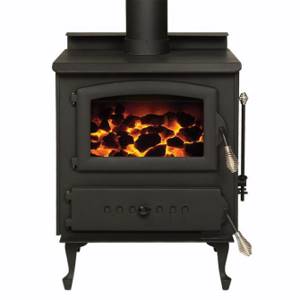
Coal furnace
Coal ranks second in terms of efficiency after gas. Long-burning coal stoves for homes have become most popular in regions where wood fuel is very expensive. The heat transfer coefficient of coal is higher, so the main fuel in many homes is brown coal or anthracite. Another advantage is the automatic operation of the furnace for loading and burning. This is unusual for wood-burning analogues.
The combustion process of coal is also different from wood. A greater increase in temperature is observed precisely on the surface of the fuel, and the smoke remains relatively cold upon exiting. Thus, the effect of long-burning coal stoves is the large size of the load and the placement of the heat exchanger directly in the fuel combustion zone.
Also, a coal stove requires forced air injection into the combustion area. Many manufacturing companies solve this problem by installing a blower fan.
Popular manufacturers
The most popular models of the furnaces in question in Russia are the domestic “Breneran” and “Professor Butakov” devices.
“Buleryan” are economical long-burning stoves, which are made of steel and have the shape of a barrel. The firebox consists of two sections and has air duct pipes. There is no ash collector. Air ducts allow you to heat neighboring rooms.
Buleryan devices operate in two modes, which include kindling and continuous burning itself. Kindling takes approximately 30 minutes. During this time, the temperature in the oven and room rises. Then the second stage begins, when the combustion chamber is completely filled with fuel, the door closes, and the air flow decreases. A single bookmark burns for about 10 hours.
As evidenced by owner reviews of Buleryan gas generator stoves, little firewood is required for kindling. One condition is that the fuel must be dry. The use of other types of fuel is not permitted. The disadvantage of the model is the need for thermal insulation of chimney pipes and incomplete combustion of the generator gas.
"Breneran" is the Russian analogue of the Canadian "Buleryan". Aluminum sleeves can be placed on convection pipes to heat adjacent rooms. However, heat losses from these pipes are very large. Therefore, it is recommended to put a casing on the model, install a manifold, and then route the pipes to adjacent rooms. Collectors and casings are not produced in series, and those made to order are practically no different in price from the cost of a heating device.
The main disadvantage of stoves lies in the smoke pipe and the condensation collector on the wall. It is impossible to make the collection airtight, because of this, vapors get into the rooms.
Models are available in various sizes. This allows the future owner to choose a stove for a specific room.
The Aqua-Breneran models are economical long-burning stoves with a water circuit. However, cold water lowers the temperature of the gases, so the volume of condensate becomes larger, and the prolonged combustion time becomes shorter.

Aqua-Breneran stove with water contour
Ovens of the “Professor Butakov” brand are more interesting in appearance than the domestic representative above. The firebox of the model has grates, pipes for convection are more efficient, and the pipe for attaching to the chimney is located on top. Water vapor flows into the oven and burns. Due to the lack of a condensation collector, cleaning the pipe becomes more difficult. Cleaning work can be carried out either from above or by moving the heating unit. Therefore, when installing the “Professor Butakov” model, it is worth placing a pedestal under it, which at the time of operation can be removed and disconnected from the chimney pipe.
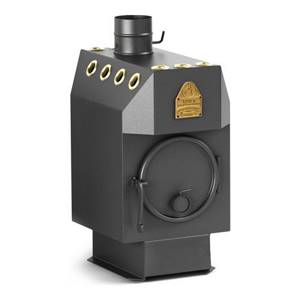
Professor Butakov Gymnasium student
Furnaces from this company are produced in different sizes. However, due to the presence of grates in the combustion chamber, long-term combustion does not last so long.
Breneran stove: simple, effective, reliable
The Breneran stove is otherwise known in the domestic heating equipment market as a “stove from Canada.”
The thoughtful design of this convection-type air heater actually allows you to heat a room for about half a day with one load of firewood.
The secondary combustion chamber is equipped with afterburner injectors with calibrated holes. Air is injected into them, which ignites unburned gases.
About 90% of small particles contained in smoke are converted into thermal energy.
The Breneran gas generator stove can be used for heating residential and utility rooms and for heating a garage. This heating device is most in demand among owners of small country houses, where they go for a weekend getaway.
The large diameter of the Breneran stove pipes allows you to put air ducts on them to supply heated air to adjacent rooms. For this purpose, you can use inexpensive ventilation hoses designed for operation in conditions of relatively low temperatures.
Since a large outflow of heat in the heating device occurs from the very surface of the furnace, heating adjacent rooms exclusively with warm air supplied through the hoses will be ineffective.
It is recommended to make a casing and a connecting manifold for the furnace, from which the piping will pass.
The operation of this furnace is associated with another problem that must be resolved independently. There is a smoke pipe on the back wall.
A tee is installed in this place, to which the chimney is connected.
The lower part is a plug glass into which condensate drains.
To prevent condensation from leaking out, the container must be carefully sealed.
Breneran gas generator furnaces are produced for rooms of various sizes. One of the varieties - “Aqua-Breneran” - is intended for connecting the stove to a water heating system.
Any organic material can serve as fuel for Breneran stoves: firewood, paper, cardboard, seed husks, bark and sawdust. Thanks to the significant volume of the firebox and the large door, large logs can be loaded into the oven without splitting.
Coal and coke cannot be used.
There are simpler, but no less effective ovens. For example, Butakov stoves, or cast iron stoves.
Information about cast iron stoves can be found at:
Tips for choosing
The main parameter that must be taken into account when choosing a long-burning stove is power and size. These two indicators are interrelated; the performance and efficiency of the entire heating system directly depends on them. Agree, if you install a high-power stove with large dimensions in a small room, it will not only take up a lot of space, but the air temperature will also be elevated, and wood fuel will be used irrationally. Accordingly, a small, low-power stove in a huge room will operate at full capacity and will fail over time.
The product range of companies is replete with choice, so choosing a design to suit your taste and for a specific room will not be difficult.
If you decide to install a stove in your dacha and have a question about hot water supply, we recommend an article about a wood-burning water heater.
Easy to use, with an interesting design, very reliable in operation - long-burning wood-burning home stoves are perfect for protecting against the cold in private homes and cottages, providing warmth around the clock. The high efficiency of these models, their safety and ease of maintenance, as well as a large selection of models make it possible for everyone to choose the heating stove for their home or summer cottage that will fully correspond to the parameters of the room.
Oven-heater “Miracle”
Such a heating device provides high-quality heating for premises of any purpose for a long time, while little fuel is wasted.
Device
This device is an all-welded steel structure. The transfer sheet divides the combustion chamber into two compartments. The top contains nozzles and an injector. At the bottom there is smoldering fuel.
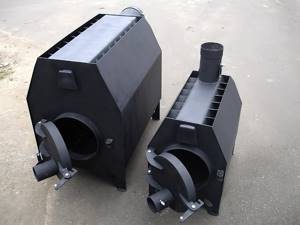
The heater is covered with a special steel casing: it reduces the heating temperature of the walls of the device and allows the heat to escape evenly. Thanks to this element, it is impossible to get burned on the stove.
Principle of operation
The process of gas generation is the smoldering of fuel with minimal access to oxygen. Re-burning of the gas occurs using special nozzles.
Such a device can be heated with firewood, garbage, dry manure, and peat. One load of fuel material provides the structure with continuous operation for 6-8 hours.
Application area
The “Miracle” stove-heater can be used for heating summer cottages, large cottages, industrial buildings, outbuildings, garages, and greenhouses.
Advantages
Such a heating device begins heating immediately after kindling. Warmth will come to the house in about 20-30 minutes. In addition, its advantages include independence from gas, oil, electricity, uniform heating of the entire room, work with any type of fuel (with the exception of coal), and high efficiency.

The Miracle oven is an economical and easy-to-use device that does not require special maintenance or care. Its combustion process can be controlled. Installation of such equipment will be inexpensive. You can cook food and heat water on it.

